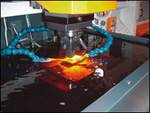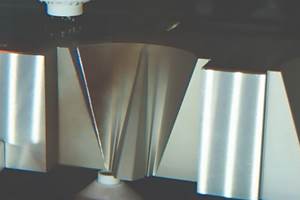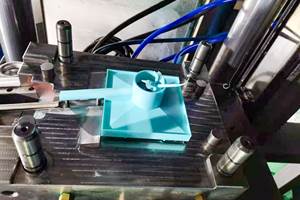Total Cost of Ownership and Productivity Analysis for EDM, Part 1
Using the graphite TCO model shows business owners how to save time and money in their EDM operation.
In the competitive moldmaking industry, throughput is the key to keeping production costs competitive. Shops want to increase productivity while maintaining profitable margins on their sinker EDM-related operations. Part of management’s strategy is often the inclusion of new equipment and technology. Investing in technology is as important to global competitiveness as optimizing asset ownership.
The TCO Analysis
The Total Cost of Ownership (TCO) model and analysis is commonly used to make decisions when purchasing new equipment. Part of this evaluation process should include an audit: an evaluation of current equipment and manufacturing operations to determine the capacity or capability for meeting present and future operational requirements. Figure 1 illustrates the events taken place during a TCO audit.
An audit is used to do the following:
• Compare actual performance versus benchmark performance of the equipment
• Examine areas to improve productivity
• Look at lost revenue due to inability to quote desired new business
• Evaluate slow production and inability to meet deadlines
• Check scrap rates due to out-of-tolerance cavities and flaws in the cavity
• Track servicing and maintenance of out-of-warranty equipment
• Analyze economics of upgrading, refurbishing or disposing of existing equipment as opposed to replacement
The main cost elements are purchase, energy, maintenance and repair. Secondary costs that have a bearing on the overall value are productivity, risk and disposal. A value assessment reflects all costs associated with a capital purchase, including owning and operating, over a given period of time. This information is a useful tool in optimizing asset ownership and determining the best value between several alternatives.
A good TCO analysis should fit the business plan and identify the best solution to match the business goals. For example, adding capabilities in order to service new customers or expand into different markets. Using new technology can often eliminate some of the process and take a fresh approach to jobs. Additional capacity and improved machine performance are often the drivers in the decision to look at equipment changes.
TCO and Electrode Material Selection
When TCO principals are applied to major elements associated with the operation of the sinker EDM equipment, such as graphite electrode materials, the value proposition and productivity of these elements start to impact profitability of owning and operating the equipment.
Using benchmark data from equipment and graphite vendors, an audit of the EDM process helps identify areas of potential savings by comparing actual costs against accepted benchmarks. Using the TCO model to audit the process may show that additional capacity can be gained from the existing equipment and the EDM hours can be reduced, thus increasing productivity. Once opportunities for improvements are identified, the TCO process is then used to identify the alternative with the lowest total cost, or best value, based on the needs of the company as identified in their business plan.
Just like equipment manufacturers, graphite manufacturers can supply models and benchmarking data to aid in the TCO analysis. The performance of the electrode is largely influenced by the grade of graphite selected. An electrode material should be selected on the ability to achieve a specific surface finish, reproduce critical detail or attain sufficient metal removal rates. Selecting a graphite material without considering the properties of the individual grade can result in poor EDM performance. Using the best graphite for the job can reduce the number of electrodes due to improved wear and reduced polishing because the desired surface finish was reached quickly.
Some graphite manufacturers publish charts or graphs that show metal removal rates, electrode wear and surface finish for specific grades under a variety of operating parameters. This information can be used as a benchmark when comparing various grades of graphite. Another tool to use when comparing graphite is photomicrographs of the microstructure of the graphite. Because the sinker EDM process is designed to produce a mirror image of the electrode shape in the work metal, the quality of the graphite is an important part of the process. Materials that have uniform structure and small grain typically are capable of reproducing a mirror image of the electrode detail in the metal cavity with fewer electrodes. Since the surface finish is also a mirror image of the microstructure of the graphite, large grain size materials with non-uniform structures typically produce finishes that require polishing.
The TCO model looks at the impact that the graphite material has on the EDM-related operations in the shop from electrode fabrication through the mold polishing operation. The goal is to identify productivity increases to reduce production costs. If the graphite grade is the limiting factor in the operation, this factor will continue to affect the operation when new equipment is purchased.
Often a different graphite grade will show enough electrode wear improvement that fewer electrodes need to be fabricated or redressed, thus reducing both consumption of graphite, milling time and tooling. Efficient EDMing with a graphite grade capable of achieving a desired surface finish can minimize polishing time. Adaptive controls respond to conditions in the gap such as excessive debris from electrode wear (graphite grains), reducing the efficiency of the cut.
It is important to use actual conditions rather than an estimate based on short test cuts. Although test cuts are fine for benchmarking or estimating performance, they don’t reveal the true cost of the graphite in EDM time and price of the material when wear and number of electrodes are considered. Comparing two grades of graphite under the actual shop environment shows the impact that graphite performance has on the job.
Part II of this article in June will examine an ownership model in an actual shop environment and will discuss the effect of the electrode material on the operation of the EDM and how the electrode material can impact the profitability of the application.
Related Content
What to Look for in Aluminum Mold Alloys
The importance of strength, anodization, weldability, machinability, flatness and porosity to aluminum injection and thermoform molds.
Read MoreSoft Wired: Cutting High Taper Angles with Wire EDM
Examine the wire’s properties to determine the right one for achieving the best cut.
Read MoreEvaluating Metal Powders for Conformally Cooled Mold Inserts
Mechanical properties and design software techniques reveal the benefits of a modified high thermal conductivity metal powder for 3D printing in moldmaking.
Read MoreProducts and Services for Multiple Moldmaking Needs
New year, new technology roundup! Featured here is a collection of product offerings, from profile milling cutters to industry-specific CAD/CAM software to innovative hot work tool steels.
Read MoreRead Next
The Graphite Grade Factor
Understanding how graphite is made will help you select the proper grade.
Read MoreHow to Use Strategic Planning Tools, Data to Manage the Human Side of Business
Q&A with Marion Wells, MMT EAB member and founder of Human Asset Management.
Read MoreReasons to Use Fiber Lasers for Mold Cleaning
Fiber lasers offer a simplicity, speed, control and portability, minimizing mold cleaning risks.
Read More













.jpg;maxWidth=300;quality=90)








